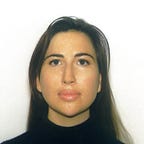Kalache looks inward in “Our Dreams are a Second Life”
By Hannah McCarthy
BEIRUT: Hiba Kalache’s “Our Dreams are a Second Life” is an exploration of dreams. This collection of drawings and paintings is largely comprised of intricate abstractions and delicate colour washes, most on expansive, unframed canvases.
On display at the Saleh Barakat Gallery, the show literally centres on a “sculptural intervention” that considers motherhood.
Kalache is interested in how text and image relate to each other. In “Lemonade Everything Was So Infinite,” her previous exhibition at this space, she explored the translation of religious texts into a visual language, drawing inspiration from the writings of the Ukrainian-born Brazilian writer Clarice Lispector.
While Lispector has continued to influence Kalache, the cerebral fuel for her new collection was primarily provided by American singer-writer Patti Smith. It was Smith’s “Year of the Monkey” that gave Kalache the title for her exhibition and the names for her artworks.
In her memoir, the singer poetically converses on politics, art, and the people in her life while exploring what the year 2016 meant for her. Dreams are a running theme throughout the book, which opens with Smith at the “Dream Motel.”
“In the Dream Motel,” Smith writes, “I was certain I did not dream, yet the more I thought about it, I realized I did dream. More precisely, I skated along the fringe of dream. First it was morning, then night, then dawn, and the rays of the sun warmed everything. I left all thoughts of the world behind and followed my dream to the sea.”
“Year of the Monkey” regularly uses the Bay Area as a backdrop, which made the memoir feel very familiar to Kalache, who spent many years in San Francisco as an artist. Natasha Gasparian, who curated this exhibition, is, however, keen to emphasize that it is too easy and shallow to view Kalache as merely a “Bay Area artist.” Similarly, Kalache is keen to be seen within her own context, as an artist in Lebanon, rather than as a Middle Eastern counterpoint to an artist in the West.
“Hiba,” Gasparian says, “is not the John Mitchell of the Middle East.”
Given Kalache’s connection with the United States and her exploration of dreams, particularly disrupted dreams, it is, however, natural to consider the political and aspirational concept of the American Dream. Kalache worked on this collection throughout the Trump presidency, which left many disillusioned with the idea of America — Smith a vocal example.
During this period, the Trump regime waged war on migrants and dismantled the promise of America. With unfeeling symbolism, Trump attacked the Dreamers’ program that protects immigrants who entered the United States illegally as children, leaving many lives and plans in disarray or limbo.
The disorientation that follows a disrupted dream is uncomfortable, as the mind shakes between a conscious and unconscious state. The idea of disrupted dreams, however, takes on a broader significance in the context of recent events and upheaval in Lebanon, the United States and elsewhere.
“I think globally, it all relates”, says Kalache.
Kalache’s abstract artworks are complex and layered. The intricate scribbles and vigorous brushstrokes create images that are “as gratifying as they are uncomfortable” says Gasparian.
In a previous exhibition, “Alternate Worlds,” Kalache responded to the Arab Spring. These works included black washes, contrasting colours and styles, as well as figurative scenes of prisoners bound and blindfolded.
Though the world today is, arguably, more chaotic than it was in 2011, the work in “Our Dreams are a Second Life” feels less direct and responsive than that in “Alternate Worlds.” There is a sense of freedom and psychological wandering in her newest pieces, as Kalache plays lightly with textures and shapes and colour. This sense of looking inward (rather than to an alternative world) brings to mind Lispector’s reflection that “it’s inside myself that I must create someone who will understand.”
For this collection, Kalache experimented with automatic drawing, where she let her hand draw as it wished — a sort of but not quite dream state, not unlike Smith’s description of “skating along the fringe of dream.”
The subject of motherhood interests Kalache as an artist, and it makes sense that she would draw inspiration from Lispector. She is one of the few female writers of the 20th century who had the opportunity to combine motherhood with a life-long career, writing unashamedly about women’s lives. Benjamin Moser, who translated Lispector’s work, notes in an article for the New Yorker that “Before Clarice, a woman who wrote throughout her life about that life was so rare as to be previously unheard of.”
The “sculptural intervention” of carefully folded and arranged fabrics on display at the heart of Kalache’s exhibition is both unashamedly maternal and quietly personal. The piece took form in the aftermath of the 4 Aug. port explosion, when folding bed sheets and pillowcases from her mother’s house and putting them aside in her studio made sense to Kalache “as a mother and a daughter.”
Beyond the domestic toil and comfort of the folding process, Kalache views it as an act where much is hidden. With the port explosion, the artist says, “we will have to wait for the truth to unfold.”
Kalache has used her latest collection to examine and analyze what is hidden between the folds of consciousness and unconsciousness. In a world where waking life has become full of horrors, the dream state becomes ever more appealing. Of course, as Smith notes in her book, “The trouble with dreaming is that we eventually wake up.”
“Our Dreams are a Second Life” is on display at the Saleh Barakat Gallery until 16 January 2020.
